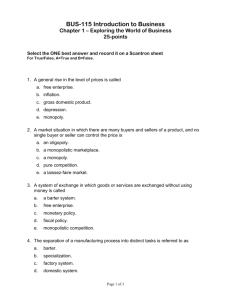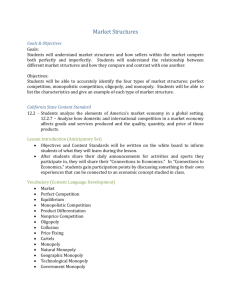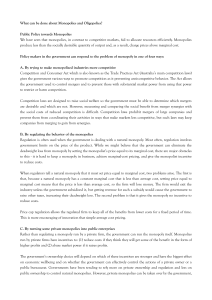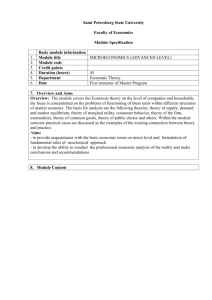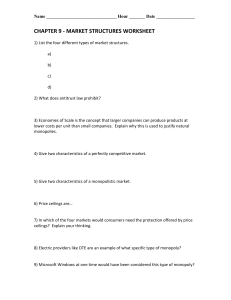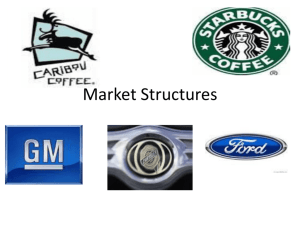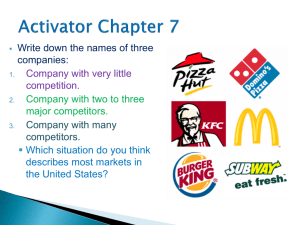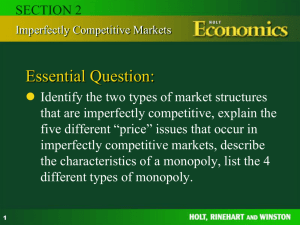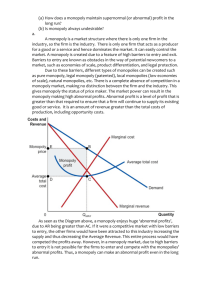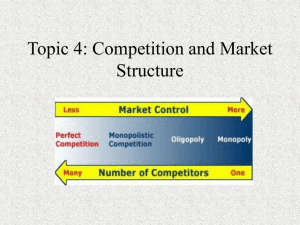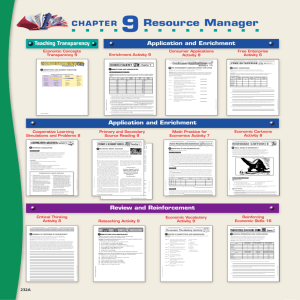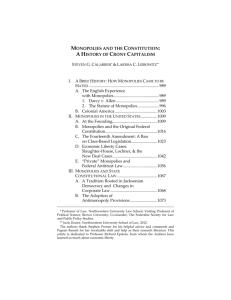Unit 2- Ch_ 7- 2 Imperfectly Competitive Markets
advertisement
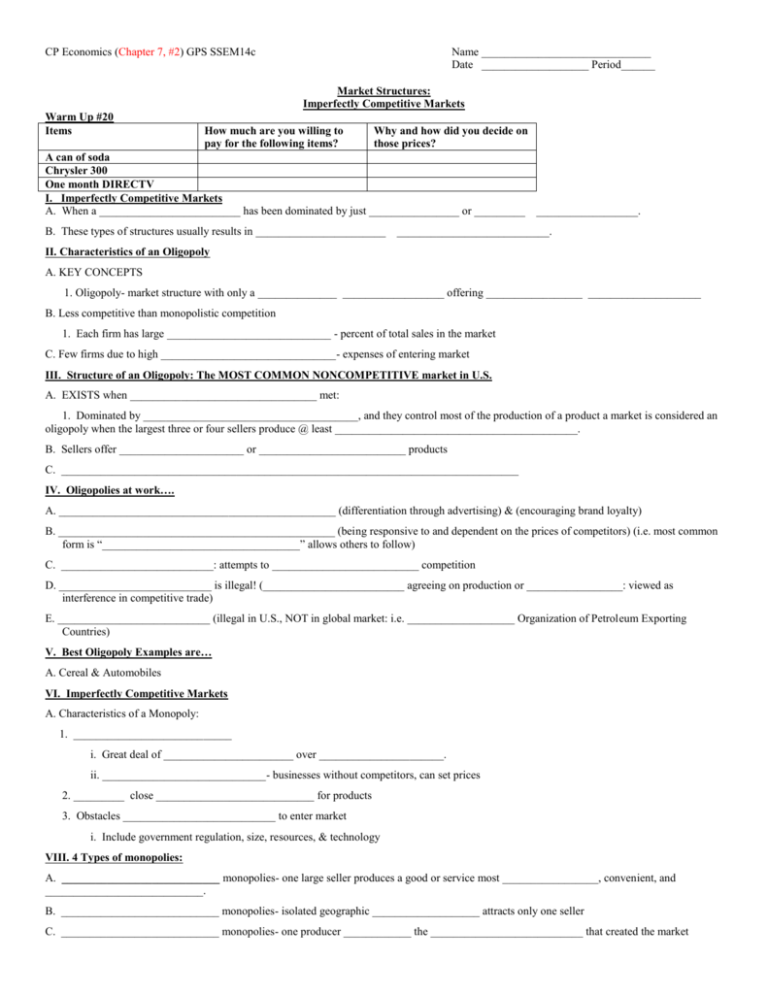
CP Economics (Chapter 7, #2) GPS SSEM14c Name ______________________________ Date ___________________ Period______ Market Structures: Imperfectly Competitive Markets Warm Up #20 Items How much are you willing to pay for the following items? Why and how did you decide on those prices? A can of soda Chrysler 300 One month DIRECTV I. Imperfectly Competitive Markets A. When a _________________________ has been dominated by just ________________ or _________ __________________. B. These types of structures usually results in _______________________ ___________________________. II. Characteristics of an Oligopoly A. KEY CONCEPTS 1. Oligopoly- market structure with only a ______________ __________________ offering _________________ ____________________ B. Less competitive than monopolistic competition 1. Each firm has large _____________________________ - percent of total sales in the market C. Few firms due to high _______________________________- expenses of entering market III. Structure of an Oligopoly: The MOST COMMON NONCOMPETITIVE market in U.S. A. EXISTS when _________________________________ met: 1. Dominated by ______________________________________, and they control most of the production of a product a market is considered an oligopoly when the largest three or four sellers produce @ least ___________________________________________. B. Sellers offer ______________________ or __________________________ products C. _________________________________________________________________________________ IV. Oligopolies at work…. A. _________________________________________________ (differentiation through advertising) & (encouraging brand loyalty) B. _________________________________________________ (being responsive to and dependent on the prices of competitors) (i.e. most common form is “___________________________________” allows others to follow) C. ___________________________: attempts to __________________________ competition D. ___________________________ is illegal! (_________________________ agreeing on production or _________________: viewed as interference in competitive trade) E. ___________________________ (illegal in U.S., NOT in global market: i.e. ___________________ Organization of Petroleum Exporting Countries) V. Best Oligopoly Examples are… A. Cereal & Automobiles VI. Imperfectly Competitive Markets A. Characteristics of a Monopoly: 1. ____________________________ i. Great deal of _______________________ over ______________________. ii. _____________________________- businesses without competitors, can set prices 2. _________ close ____________________________ for products 3. Obstacles ___________________________ to enter market i. Include government regulation, size, resources, & technology VIII. 4 Types of monopolies: A. ____________________________ monopolies- one large seller produces a good or service most _________________, convenient, and ____________________________. B. ____________________________ monopolies- isolated geographic ___________________ attracts only one seller C. ____________________________ monopolies- one producer ____________ the ___________________________ that created the market D. ____________________________ monopolies- ______________________ is the sole _________________ of a product (i.e. public goods) IX. Examples of the Types of Monopolies A. Example 1: Natural Monopoly _________________________________ 1. In some markets, ______________________________ to have companies competing 2. Example: public utilities that require complex systems i. _______________________________________-- average production _________________________________________; the more people you service cost continues to fall 3. Government (local) both ________________________ and regulates this business B. Example 2: Government Monopoly: ___________________________________________ 1. ___________________________________ runs some businesses that provide goods and services i. private firms cannot or do not want to provide because of __________________________________ 2. Example: Postal Service has sole right to deliver first-class mail 3. New services and ___________________________________________________________ i. private delivery companies FedEx, UPS, DHL, fax, email, _________________________________________________ C. Example 3: Technological Monopoly: ________________________________________ 1. _________________________________- legal registration of ____________________________; gives inventor sole rights i. enables businesses to recover costs of development 2. Monopoly lasts for a time limit of 20 years or until ________________________ invented 3. Patent let ________________________________________________ out of instant-photography market ii. simpler _______________________________, digital cameras, cell phones, quick processing reduced its market D. Example 4: Geographic Monopoly: ______________________________________________ 1. ________________________________________ tie teams to ______________________, regions; limit number of teams i. owners can charge __________________________________ prices, sell team merchandise 2. Physical isolation- no other supplier in area- lets _______________________________________________ 3. Very _____________________________________ may not support two businesses of same type (i.e. Orlando Magic) X. Best Monopolies Examples are… A. Cable Television Market. XI. Technological Monopolies at Work A. _____________________________ 1. Grants ______________________________________, works of art, music, exclusive rights to publish, duplicate, perform, display, and ___________________ their __________________________ works. B. _____________________________ 1. Grants a company or an individual exclusive rights to ______________________________, use or rent, and _______________ an invention or discovery for 20 years in the U.S. XII. Factors that affect prices in Oligopolies and Monopolies: A. ______________________________________________________ B. ______________________________________________________ C. ______________________________________________________ Answer Closure Activity #18 1. Consumers have most influence A. & most choice in monopolistic competition. 2. Consumers have some influence B. & little choice in perfect competition. 3. Consumers have limited influence C. in a monopoly. 4. Producers have the most control D. with some choice in oligopolies.





